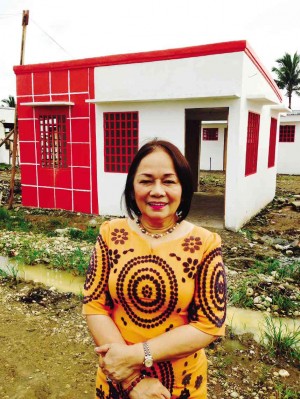Aquino no-show for ‘Pablo’ victims

DAVAO ORIENTAL Gov. Corazon Malanyaon in front of one of at least 50 houses that were supposed to be turned over by President Aquino to beneficiaries yesterday. NICO ALCONABA/INQUIRER MINDANAO
CATEEL, Davao Oriental—The houses had been painted yellow, the color associated with President Aquino. Some had been painted red and white, colors associated with the Department of Social Welfare and Development (DSWD).
Gov. Corazon Malanyaon, who supported ex-senator Manny Villar in the last elections who is associated with the color orange, ordered up to 50 houses for victims of Typhoon Pablo painted yellow and red and white in anticipation of Mr. Aquino’s arrival.
A stage had been built here supposedly for ceremonies for the turnover of the housing units by the President himself to beneficiaries. Yesterday afternoon, the stage had been demolished after officials of the province learned that Mr. Aquino is not coming at all.
Prescilla Razon, regional head of DSWD, said officials had picked this town as site of the turnover “because wherever you look, you see houses.”
Construction workers did not mind the presence of the officials on the site of the houses. They were busy beating the Dec. 4 deadline because the President was coming.
Article continues after this advertisementMany of the beneficiaries, survivors of Pablo, were just across the street in bunkhouses and huts.
Article continues after this advertisementThe government had planned to build thousands of 5.10 x 4.3-meter box-type shelters in this town and Baganga and Boston for the storm survivors.
Clint Nikko Morales, field engineer of the provincial government, said the construction of the houses was delayed because contractors considered the P100,000 budget per unit too low.
“They do not see profits from the project,” said Morales, adding that some contractors had been convinced to take on the project as a form of assistance for the storm victims.
Pablo destroyed at least 42,900 houses in the three towns alone. Some survivors had rebuilt their homes without government help.
While the town centers are again alive, survivors are still adjusting to a life altered by the storm.
Take the case of James Mandawe, 31, who now lives with his wife and children in a shelter provided by the Philippine National Red Cross after staying for nine months in a tent city managed by the Balay Mindanaw Foundation Inc.
Mandawe’s brother, Jessie, and 10 others, died when the daycare center they took shelter in collapsed at the height of Pablo.
In the village of Kinablangan, at least 10 families, who lost their homes, are still living in tents as they wait for government-funded housing units.
Many of those rendered homeless had received shelters from nongovernment organizations.
Mandawe said he is still waiting for a housing unit in a relocation site identified by the government.
With the slow-paced construction of government housing units, some survivors are now expecting to stay for good in supposedly temporary shelters.
Some had availed themselves of the P10,000 financial aid given by government to people who wanted to repair their homes. They lost homes, too, but would rather start building one on their own instead of waiting for the government-built houses. Nico Alconaba, Inquirer Mindanao